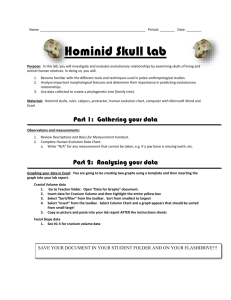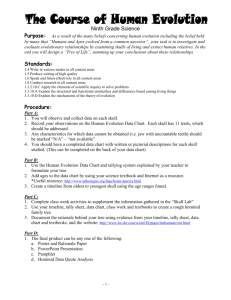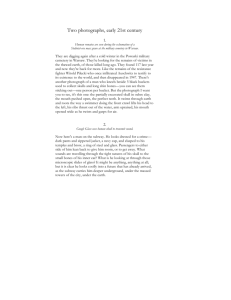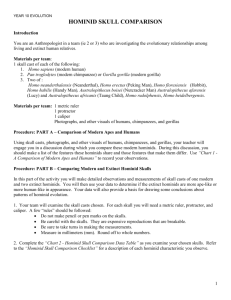27July2012_activity_CRANIAL CAPER
advertisement
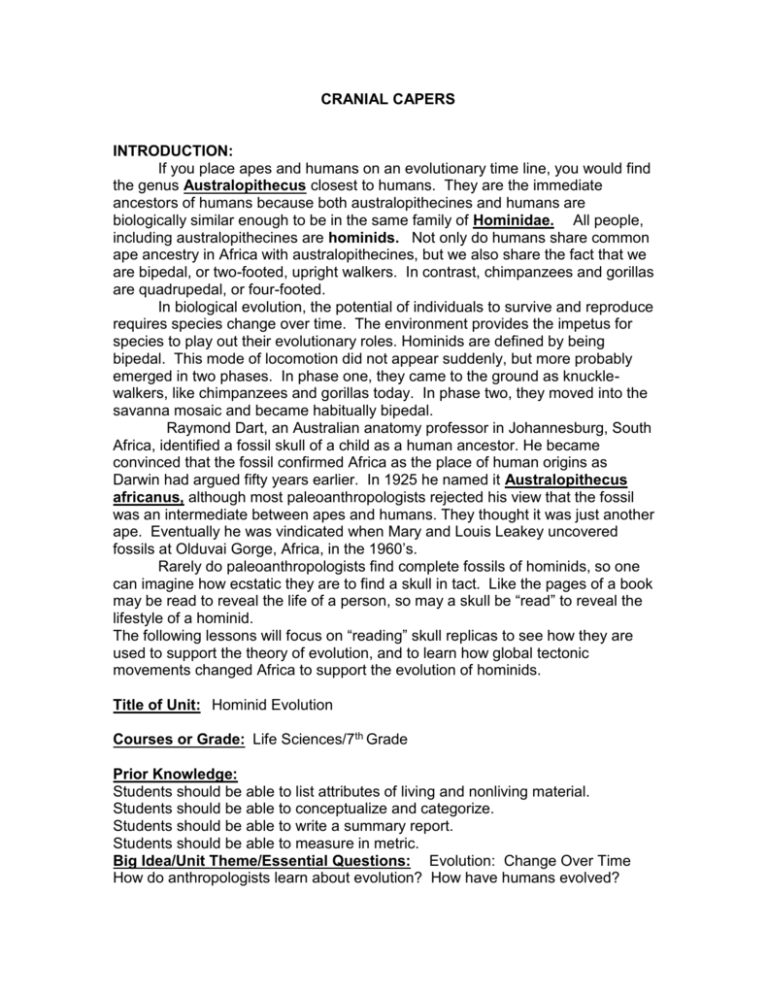
CRANIAL CAPERS INTRODUCTION: If you place apes and humans on an evolutionary time line, you would find the genus Australopithecus closest to humans. They are the immediate ancestors of humans because both australopithecines and humans are biologically similar enough to be in the same family of Hominidae. All people, including australopithecines are hominids. Not only do humans share common ape ancestry in Africa with australopithecines, but we also share the fact that we are bipedal, or two-footed, upright walkers. In contrast, chimpanzees and gorillas are quadrupedal, or four-footed. In biological evolution, the potential of individuals to survive and reproduce requires species change over time. The environment provides the impetus for species to play out their evolutionary roles. Hominids are defined by being bipedal. This mode of locomotion did not appear suddenly, but more probably emerged in two phases. In phase one, they came to the ground as knucklewalkers, like chimpanzees and gorillas today. In phase two, they moved into the savanna mosaic and became habitually bipedal. Raymond Dart, an Australian anatomy professor in Johannesburg, South Africa, identified a fossil skull of a child as a human ancestor. He became convinced that the fossil confirmed Africa as the place of human origins as Darwin had argued fifty years earlier. In 1925 he named it Australopithecus africanus, although most paleoanthropologists rejected his view that the fossil was an intermediate between apes and humans. They thought it was just another ape. Eventually he was vindicated when Mary and Louis Leakey uncovered fossils at Olduvai Gorge, Africa, in the 1960’s. Rarely do paleoanthropologists find complete fossils of hominids, so one can imagine how ecstatic they are to find a skull in tact. Like the pages of a book may be read to reveal the life of a person, so may a skull be “read” to reveal the lifestyle of a hominid. The following lessons will focus on “reading” skull replicas to see how they are used to support the theory of evolution, and to learn how global tectonic movements changed Africa to support the evolution of hominids. Title of Unit: Hominid Evolution Courses or Grade: Life Sciences/7th Grade Prior Knowledge: Students should be able to list attributes of living and nonliving material. Students should be able to conceptualize and categorize. Students should be able to write a summary report. Students should be able to measure in metric. Big Idea/Unit Theme/Essential Questions: Evolution: Change Over Time How do anthropologists learn about evolution? How have humans evolved? What environmental changes occurred to provide a stage for human evolution? Science Content Standards of Lesson: 3. Biological evolution accounts for the diversity of species developed through processes over many generations. As a basis for understanding this concept: a. Students know both genetic variation and environmental factors are causes of evolution and diversity of organisms. b. Students know how independent lines of evidence from geology, fossils, and comparative anatomy provide the bases for the theory of evolution. Social Sciences Standards of Lesson: Chronological and Spatial Thinking 2. Students construct various time lines of key events, people, and Periods of the historical era they are studying. Lesson Objectives: Students will: 1. Create a concept map and summary report about evolution of hominids. 2. Compare and contrast similarities and differences of primate and hominid skulls 3. Students create an organism for the year 1,002,004 that has undergone evolutionary changes. 4. Complete a data chart of hominid measurements. 5. Create a time line of hominid evolution. 6. Develop a map of Africa indicating results of global tectonic movement and environmental changes. Length of Lesson: Seven 90-minute periods Materials: K-W-L chart per student skull photos chart paper Transparency of K-W-L chart Opening Activity: Constructing Prior Knowledge 1. Distribute copies of the 11 x 14 K-W-L charts to the students. Allow them a few minutes to write what they know about skulls. 2. Display the skull photos with chart paper at various stations around the room. Instruct a group (4 students) to go to station 1 and make observations about the photo at that station. They should write 1 observation agreed upon by the group on the chart paper and then move on to the other stations in order. When they have completed the tour of the stations they should return to their seats and add, delete or modify what they have written on their charts. The students waiting in their seats should look at the resource materials on their tables. Guide students in generating questions and writing them in the second column (Want To Learn). 2. Questions may be developed from the discussion about the photos, from the resource material, or the news article. 3. When group 1 has moved on to station 2, another group should visit station 1. Each group should have about 3 minutes at each station. 4. Distribute copies of the article, “Skulls Found in Africa and in Europe Challenge Theories of Human Origins” written by John Noble Wilford, for the New York Times, August 7, 2002.http://www.nytimes.com/learning. 5. Assign a paragraph to each group to read and discuss among themselves. They should select a spokesperson from the group to report to the whole class. 6. When the article has been read and discussed, instruct students to add information to their K-W-L charts. They may have more questions or they may have found answers to questions they have already written. The three columns of the chart should be complete at this time. 7. Homework Assignment: 1. Students are to read each of the statements they have written in columns 1 and 3 of the K-W-L charts and label them with categories that they brainstorm. Examples: structure, function, paleontologists, location, geologic time period, theory, etc. 2. Students are given a Frayer Model vocabulary foursquare activity sheet and a list of vocabulary words. (See attachment) They are to enter each word in the center circle and complete the instructions in each square for defining the word. Square One: Textbook sentence with the Vocabulary word underlined; Square Two: Student’s own definition; Square 3: Dictionary/glossary definition; Square Four: Student generated sentence encompassing the vocabulary word. (See attachment) 1. 2. 3. Activity 2: Concept Mapping Student Activity Displaying the K-W-L chart on the projector screen, the instructor will model how each of the statements is to be labeled with a category. Remind students that no two charts are alike so they will need to label their own statements with the categories they have written under the heading “Categories We Expect to Use”, at the bottom of their charts. Allow time for students to label their statements if they have not already done so. They should use the first letter of each category to label the statements. Students are to create a concept map by placing the topic “skulls” in a circle in the middle of a sheet of paper. The categories they used to organize their statements will become the major concept headings radiating from the center circle. Connecting lines show the relationship of the main topic to the categories and explanatory details that are written on circles connected to the lines. Students will use the software program Inspirations to make a computergenerated concept map and outline. Culminating Activity/Assessment: Students will write a summary report from the outline generated by the software program. They will submit their K-W-L charts, concept maps and summaries for assessment. Rubric: See attachment for the concept map and summary rubrics. Activity 3: Now That’s Using Your Head! From Sample AIMS Investigations Brochure AIMS Education Foundation P.O. Box 8120 Fresno, California 93747 Materials: one tape measure (per pair of students) 1 yardstick (per pair of students) worksheet (per student) one calculator (per pair of students) Introduction: Very rarely are complete fossil remains of human organisms found. Fortunately, skulls of hominids have been discovered on many continents and have been used to further the evolution theory. One may think that very little can be determined with so little to work with, but thanks to anthropometry, anthropologists are able to learn a great deal from a skull. This activity will allow students to explore the relationship between their heights and the circumference of their heads. Procedure: 1. Students make predictions of how much greater their height is than the circumference of their heads. They should record their prediction on their worksheet. 2. Next students will estimate his or her height and the circumference of his or her head and record it on the worksheet. 3. Working in pairs, students measure each other for height and circumference of their heads. They should record the information on their worksheets and find the difference between their estimate and actual measurements. 4. The students will then compute how many times greater their heights are by dividing their heights by the circumferences of their heads and rounding the numbers to the nearest tenth. 5. Compute the group average ratio and record as a decimal. 6. The class height to circumference of the head can then be calculated using a calculator and recorded. 7. To apply what they have learned, students are given the circumference or the height of the instructor and ask students to predict the instructor’s height or head 8. circumference. (See attachment for worksheet). Discussion Questions: 1. Were you close in your prediction of how many times greater your height was than the circumference of your head? Why or why not? 2. Is there a close relationship between height and circumference of the head? What is that relationship? How can this relationship help anthropologists? Extension: Students can explore “The Golden Proportion” that anatomists use to determine the height of an individual using a formula based on the length of the thigh bone. For males: Height = length of femur x 1.88 + 813.06 millimeters. For females: Height = length of femur x 1.945 + 728. 44 millimeters. NOW THAT’S USING YOUR HEAD! Prediction: My height is _____________ times greater than the circumference of my head at its widest point. Measurements: Estimate Actual Difference Height _______cm ______cm ________cm Circumference of head _______cm ______cm ________cm Ratio of height to head Circumference ________cm _______cm Height divided by circumference Of head ________cm ________cm ________cm Group average ratio (decimal) ________ Class average ratio (decimal) ________ VOCABULARY ________cm 1. anthropometry 11. anthropology 2. cranium 12. canine diastema 3. cranial module 13. sagittal crest 4. hominid 14. dental arcade 5. foramen magnum 15. facial slope 6. forehead 16. prognathism 7. incisors 17. canine 8. premolars 18. molars 9. postorbital constriction 19. calipers 10. supraorbital ridge 20. braincase Activity 4: Cracking The Cranial Codes Introduction: This lab introduces students to anthropometric measurements as a means of studying evolution. Students will observe, measure, compare and contrast anatomical variations for each of the seven replica skulls of hominids placed in stations around the room. The measurement guide and the data recording sheet were adapted from a lesson posted at www.carolina.com/anthropology/index.asp Objective: 1. Students will become familiar with anthropometric terms and techniques used by paleoanthropologists. 2. Students will identify the homologous structures. 3. Students will collect and analyze data by measuring homologous features of skull replicas. Materials: seven skulls calipers calculators Science journals data sheet rulers Procedure: 1. Place a skull, a caliper, a ruler, a tape measure and a protractor at each station. 2. Give each student a data sheet and each group of four students a skull measurement guide. 3. Instruct one group to go to the first station and begin measuring the skull replica. Each student is to participate fully by undertaking a specific task at the station. After 5 to 7 minutes, instruct the group to move to station two as another group begins work at station one. Students are to continue to rotate until they have visited each station. Students should make sketches of the most pronounced features of the skulls in their journals and record the measurement data on the worksheet. 4. After all measurements have been taken, students are to return to their seats to analyze and discuss the data within their group. Have students look for patterns represented by their data: a. List the features that all the skulls have in common b. List the features that are most helpful for distinguishing among the replicas. 5. Hold a whole group discussion about the data: a. Why do you think the canine tooth reduced in size so much from earlier to later hominids? (Grasping function of long canines replaced by easy use of Hands, associated with bipedalism.) b. Why do you think the face flattens over time in hominids? (Similar reason as for item one.) c. How does the position of the foramen magnum relate to the body posture and locomotor pattern of the animal? (More forward and under the skull, associated with erect posture of bipedalism; skull balances on top of spinal column. With semi-erect posture of apes, foramen magnum is located more to the rear of the skull.) d. Have we really lost the browridge? (Not really; forehead rises directly above the browridge, enclosing the much-enlarged frontal lobes.) Extension: Students are given a blank timeline and small photos of the seven skull replicas. Using research, students are to find the period on the timeline that each of the skulls fit into. They should cut the photos apart and glue them on the timeline in the correct location. Social Sciences Connection: Our Ancestors 1. Using information entitled Our Ancestors from Prehistoric Ages an Usborne book, students will complete a chart that requires time period, weight, height, skull location, and accomplishment of early ape to modern man. 2. Secondly, students will create an Ancestor Map using information taken from Famous Finds, in Prehistoric Ages. They are to label the continents and oceans, draw a legend and place a marker where each of the ancestors was found. 3. The last activity requires students to create an ancestor timeline from the data they have collected. (See attachments for chart and information pages) Australopithecus boisei: His age is about 1.75 million years; Lower Pleistocene; discovered by Mary Leakey in 1959 in he Olduvai Gorge, Tanzania. The specimen is a nearly complete skull with teeth. It has a large face and palate, molars and premolars much larger than incisors and canines. The cranial vault is low and has a marked post-orbital constriction with strong brow ridges. The cranial capacity is 530 cc with a sagittal crest . This is a very robust species of Australopithecus. He was bipedal and erect. He has no simian shelf or chin. Australopithecus africanus: Age is perhaps between 3 and 2 million years; Pliocene period. He was discovered in Taung, Cape Province, South Africa, in 1924 by Raymond Dart. The specimen has milk teeth and first permanent molars present. Canines and premolars are small relative to molars. The specimen has a “v” shaped dental arcade. This species has small canine diastema. The postcranial skeleton is unknown. It may be the first hominid species or a specialized small ape. Homo sapiens sapiens: This specimen is about 30,000 – 50,000 years old; Upper Pleistocene. He was located in La Ferrassie, Dordogne, France by L. Capitan and D. Peyrony in 1909. The skeleton was of an adult male (several other skeletons are known from this site) and it was a deliberate burial. The skull is large with a high forehead and vault. The face is large and he has rather large brow ridges. There is a rounded occipital region and a definite chin is present. He differs in no major way from modern humans. The cranial capacity is 1520cc. Gorilla gorilla: The earliest fossil apes are known from Miocene sites about 17 to 20 mya. Dentally these early apes are distinct from monkeys and represent several genera and a number of species. By the middle Miocene, the distribution of fossil apes extended beyond Africa to Europe and Asia, and the number of species notably expanded. By the end of the Miocene, fossil apes had virtually disappeared. Miocene ape fossils cannot linked directly to any of the living apes. Molecular studies now delineate two species of gorilla. The mountain gorilla (Gorilla beringei beringei) of Uganda, Rwanda, and Congo is the mot studied and endangered of the gorillas. The Western lowland gorillas (Gorilla gorilla) inhabit Congo, Central African Republic, Gabon and a small population remains in Nigeria. They are the largest of the great apes, and dangerously few of them remain. They are intelligent peaceful and persistent problem solvers. Gorillas weigh 300-400 pounds and stand 6’ tall. Chimpanzee: (Pan troglodytes) They are native to the African rain forests, and they are highly intelligent and social. They are capable of insight and have the human ability to use tools. Chimps closely resemble humans both behaviorally and genetically. Homo sapiens: Human Asian Male. Having evolved from algae, this persistent species has managed to inhabit even the most undesirable of environments. Although humans inhabit many states, they are most often found in the state of confusion. Australopithicus boisei: Female specimen.
